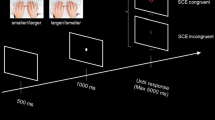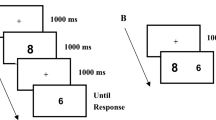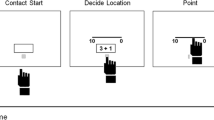Abstract
We investigated the role of horizontal body motion on the processing of numbers. We hypothesized that leftward self-motion leads to shifts in spatial attention and therefore facilitates the processing of small numbers, and vice versa, we expected that rightward self-motion facilitates the processing of large numbers. Participants were displaced by means of a motion platform during a parity judgment task. We found a systematic influence of self-motion direction on number processing, suggesting that the processing of numbers is intertwined with the processing of self-motion perception. The results differed from known spatial numerical compatibility effects in that self-motion exerted a differential influence on inner and outer numbers of the given interval. The results highlight the involvement of sensory body motion information in higher-order spatial cognition.

Similar content being viewed by others
Notes
Spatial numerical association of response codes effects are usually indicated by a negative regression slope of dRT as a function of numbers whereby individual regression slopes are tested against zero by means of a simple t test. In the present report, we analyzed linear (and cubic) effects within the framework of repeated measures ANOVA as suggested by (Pinhas et al. 2011).
Note that the outer numbers in this study (“1” and “9”) where not the same as those used in the previous study (“2” and “8”). This suggests that the observed pattern of dRT represents an influence of self-motion direction on the outer numbers of a given interval.
References
Conson M, Mazzarella E, Trojano L (2009) Numbers are represented in egocentric space: effects of numerical cues and spatial reference frames on hand laterality judgements. Neurosci Lett 452(2):176–180
Dehaene S, Bossini S, Giraux P (1993) The mental representation of parity and number magnitude. J Exp Psychol Gen 122(3):371–396
Fias W, Fischer MH (2005) Spatial representation of numbers. In: Campbell JID (ed) Handbook of mathematical cognition. Psychology Press, New York, pp 43–54
Figliozzi F, Guariglia P, Silvetti M, Siegler I, Doricchi F (2005) Effects of vestibular rotatory accelerations on covert attentional orienting in vision and touch. J Cogn Neurosci 17(10):1638–1651. doi:10.1162/089892905774597272
Gevers W, Reynvoet B, Fias W (2003) The mental representation of ordinal sequences is spatially organized. Cognition 87(3):B87–B95. doi:10.1016/S0010-0277(02)00234-2
Gevers W, Verguts T, Reynvoet B, Caessens B, Fias W (2006) Numbers and space: a computational model of the SNARC effect. J Exp Psychol Hum Percept Perform 32(1):32–44. doi:10.1037/0096-1523.32.1.32
Gobel SM, Calabria M, Farne A, Rossetti Y (2006) Parietal rTMS distorts the mental number line: simulating ‘spatial’ neglect in healthy subjects. Neuropsychologia 44(6):860–868
Grabherr L, Nicoucar K, Mast FW, Merfeld DM (2008) Vestibular thresholds for yaw rotation about an earth-vertical axis as a function of frequency. Exp Brain Res 186(4):677–681. doi:10.1007/s00221-008-1350-8
Hartmann M, Grabherr L, Mast FW (2011) Moving along the mental number line: Interactions between whole-body motion and numerical cognition. J Exp Psychol Hum Percept Perform (no pagination specified). doi:10.1037/a0026706
Hubbard EM, Piazza M, Pinel P, Dehaene S (2005) Interactions between number and space in parietal cortex. Nat Rev Neurosci 6(6):435–448
Loetscher T, Schwarz U, Schubiger M, Brugger P (2008) Head turns bias the brain’s internal random generator. Curr Biol 18(2):R60–R62
Loftus AM, Nicholls MER, Mattingley JB, Bradshaw JL (2008) Left to right: representational biases for numbers and the effect of visuomotor adaptation. Cognition 107(3):1048–1058
Moyer RS, Landauer TK (1967) Time required for judgements of numerical inequality. Nature 215(5109):1519–1520
Pinhas M, Tzelgov J, Ganor-Stern D (2011) Estimating linear effects in ANOVA designs: The easy way. Behav Res Methods. doi:10.3758/s13428-011-0172-y
Rossetti Y, Jacquin-Courtois S, Rode G, Ota H, Michel C, Boisson D (2004) Does action make the link between number and space representation? Visuo-manual adaptation improves number bisection in unilateral neglect. Psychol Sci 15:426–430
Zorzi M, Priftis K, Umilta C (2002) Brain damage: neglect disrupts the mental number line. Nature 417(6885):138–139
Acknowledgments
This study was funded by the Swiss National Science Foundation (Pro*Doc grant PDFMP1_127238 and Sinergia grant CRSII1-125135/1).
Conflict of interest
This supplement was not sponsored by outside commercial interests. It was funded entirely by ECONA, Via dei Marsi, 78, 00185 Roma, Italy.
Author information
Authors and Affiliations
Corresponding author
Rights and permissions
About this article
Cite this article
Hartmann, M., Farkas, R. & Mast, F.W. Self-motion perception influences number processing: evidence from a parity task. Cogn Process 13 (Suppl 1), 189–192 (2012). https://doi.org/10.1007/s10339-012-0484-6
Published:
Issue Date:
DOI: https://doi.org/10.1007/s10339-012-0484-6




